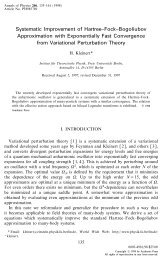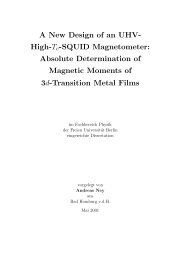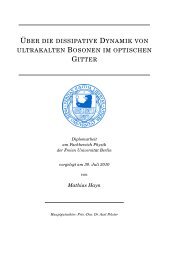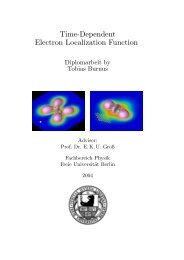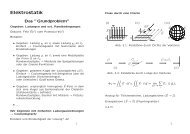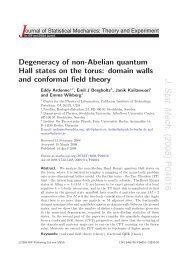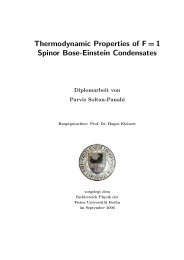Diploma thesis - Fachbereich Physik
Diploma thesis - Fachbereich Physik
Diploma thesis - Fachbereich Physik
You also want an ePaper? Increase the reach of your titles
YUMPU automatically turns print PDFs into web optimized ePapers that Google loves.
3.3. GROUND-STATE ENERGY WITH EXTERNAL CURRENT 47<br />
(2.138),<br />
Z =<br />
∮ { ∫ ¯hβ M<br />
Dδx exp − A(X) − dτ[<br />
1¯h<br />
1¯h 0 2 δẋ2 (τ) (3.44)<br />
+ M (<br />
2 ω2 1 + 6gAX )<br />
Mω + 12g2 BX 2<br />
δx 2 + ( gA + 4g 2 BX ) ]}<br />
δx 3 + g 2 Bδx 4 ,<br />
2 Mω 2<br />
where, according to the background method, the first order term has been omitted, and<br />
the integration runs over all fluctuations δx that are periodic in the imaginary time, i.e.<br />
δx(0) = δx(¯hβ). Due to (2.37) and (2.127), one has the following relation between the<br />
partition function Z and the effective potential:<br />
Z = exp [−βV eff (X)] . (3.45)<br />
And by comparing (3.44) and (3.45), one obtains<br />
∮ {<br />
exp [−βV eff (X) + βV (X)] = Dδx exp − 1¯h<br />
∫ ¯hβ<br />
dτ (3.46)<br />
0<br />
[ M<br />
×<br />
2 δẋ2 (τ) + M (<br />
2 ω2 1 + 6gAX )<br />
Mω + 12g2 BX 2<br />
δx 2 + ( gA + 4g 2 BX ) ]}<br />
δx 3 + g 2 Bδx 4 .<br />
2 Mω 2<br />
In Section 2.7 and 2.8, we have evaluated the expression on the right-hand side of the<br />
last identity in the saddle-point approximation, i.e. we have performed an expansion in ¯h.<br />
However, in (3.46), the powers of the fluctuations δx are not related to the powers of the<br />
coupling constant g. Taking into account that the potential (3.4) vanishes at the origin, one<br />
obtains from (3.46)<br />
exp[−βV eff (X = 0)] = (3.47)<br />
∮ {<br />
Dδx exp − 1¯h<br />
∫ ¯hβ<br />
[ M<br />
dτ<br />
2 δẋ2 (τ) + M ]}<br />
2 ω2 δx 2 + gAδx 3 + g 2 Bδx 4 .<br />
Thus, the effective potential can be transformed according to<br />
V eff (X) = V (X) + V eff (X = 0) ∣<br />
0<br />
∣<br />
ω 2 =Ω 2 , A=A+4gBX<br />
, (3.48)<br />
where Ω is defined by (2.157). It is important to note that in contrast to (3.46), there<br />
is a fixed relation between the powers of the fluctuations and the coupling constant in<br />
(3.47). Therefore, except for the tree-level, an expansion for the effective potential in the<br />
coupling constant g can be transformed into the corresponding ¯h-expansion by performing<br />
the substitutions<br />
X → 0 , ω → Ω , A → A + 4gBX (3.49)<br />
in (3.42) and reintroducing ¯h (and M) into Tab. 3.3. Evaluating (3.42), Tab. 3.3 in the<br />
second order of the coupling constant according to (3.49) reproduces (2.165). In the fourth<br />
order, one reobtains (2.170). In general, when the ¯h-expansion is given in the form<br />
V eff (X) =<br />
N∑<br />
¯h l V (l) (X) + O(¯h N+1 ) , (3.50)<br />
l=0




